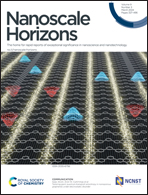High current treated-passivated graphene (CTPG) towards stable nanoelectronic and spintronic circuits†
Abstract
Achieving enhanced and stable electrical quality of scalable graphene is crucial for practical graphene device applications. Accordingly, encapsulation has emerged as an approach for improving electrical transport in graphene. In this study, we demonstrate high-current treatment of graphene passivated by AlOx nanofilms as a new means to enhance the electrical quality of graphene for its scalable utilization. Our experiments and electrical measurements on large-scale chemical vapor-deposited (CVD) graphene devices reveal that high-current treatment causes persistent and irreversible de-trapping density in both bare graphene and graphene covered by AlOx. Strikingly, despite possible interfacial defects in graphene covered with AlOx, the high-current treatment enhances its carrier mobility by up to 200% in contrast to bare graphene samples, where mobility decreases. Spatially resolved Raman spectroscopy mapping confirms that surface passivation by AlOx, followed by the current treatment, reduces the number of sp3 defects in graphene. These results suggest that for current treated-passivated graphene (CTPG), the high-current treatment considerably reduces charged impurity and trapped charge densities, thereby reducing Coulomb scattering while mitigating any electromigration of carbon atoms. Our study unveils CTPG as an innovative system for practical utilization in graphene nanoelectronic and spintronic integrated circuits.



 Please wait while we load your content...
Please wait while we load your content...